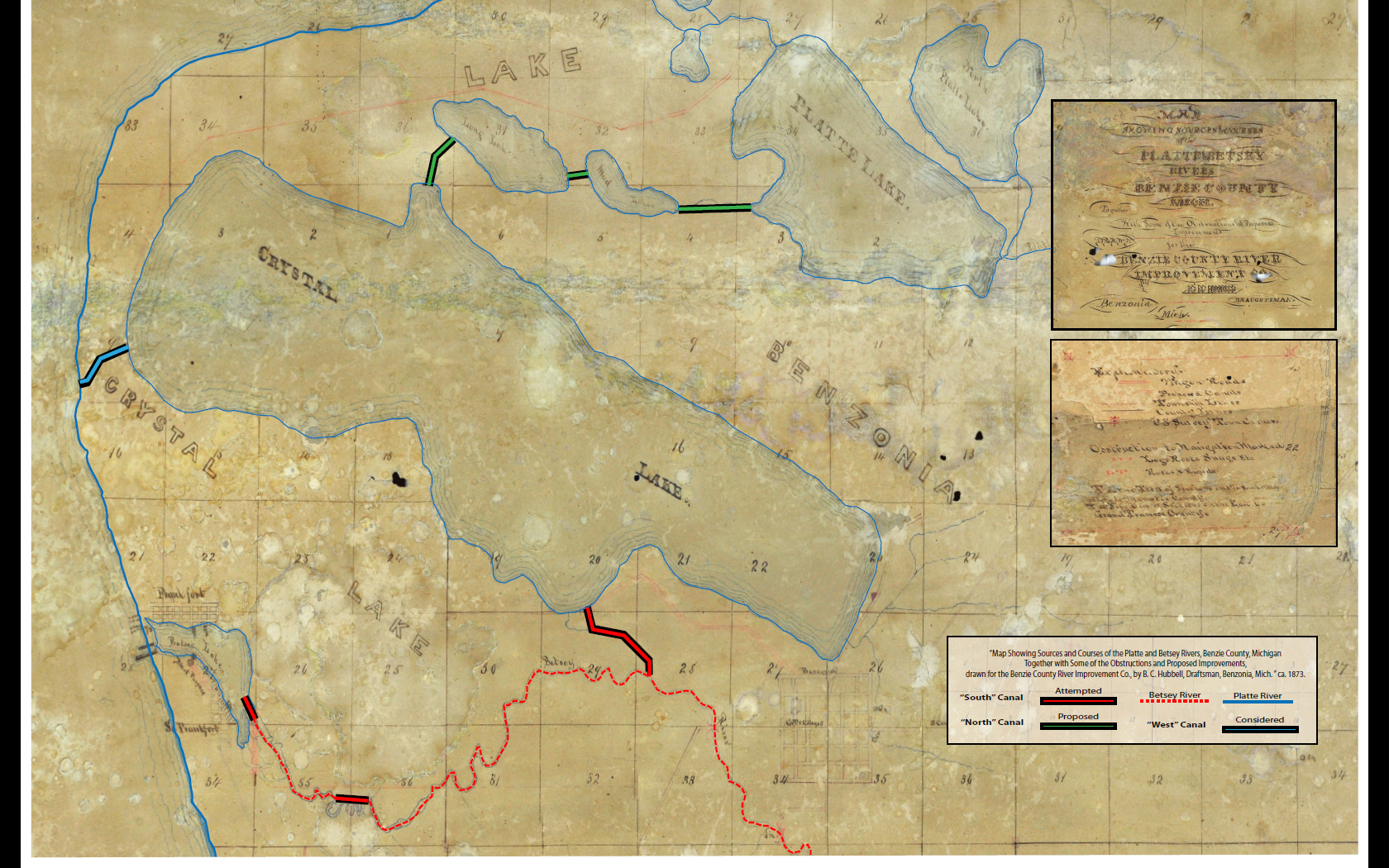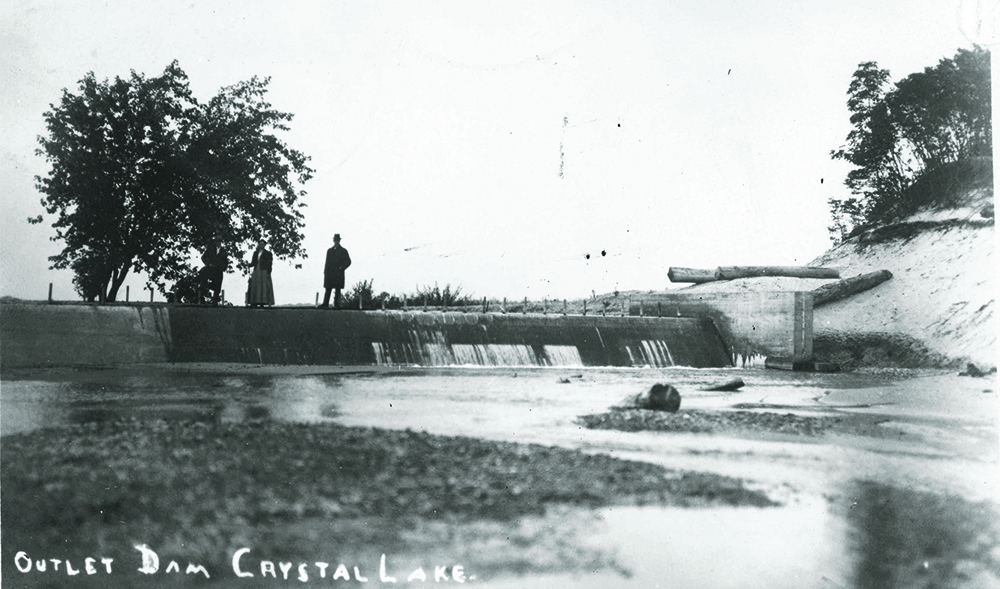Details of the Tragedy… err, Comedy
By Stacy L. Daniels
Archibald Jones founded the Benzie County River Improvement Co. in 1873 with the intention of improving water lots on Crystal Lake, removing obstructions between Crystal Lake and Lake Michigan, and building a steamboat to facilitate the shipment of settlers and goods to and from the interior of the county to the nearby port of Frankfort. The dramatic lowering of a very large inland lake by 20 feet and the creation of a 21-mile perimeter of sandy beach ensured the future of Crystal Lake as a prime recreational area. It is unique in the histories of Michigan’s inland lakes, and it is still to this day one of the most spectacular and long-lasting river-improvement projects of its time.
The role of Archibald Jones, the man who (allegedly) pulled the plug at Crystal Lake, involved travels of a typical 1800s American family, searching for opportunities, experiencing adventures, and facing vicissitudes posed by the opening of the Midwest. The lowering of Crystal Lake has elements of both tragedy and comedy — a serious beginning with a happy ending, as well as perceived foibles of human nature and realized unintended consequences associated with bold ventures.

Archibald Jones was a true entrepreneur. He was a farmer, horse trader, carriage maker, fruit grower, estate overseer, cattle rancher, and eventually even a canal builder, as this tale goes. He moved progressively with his wife and eight children from New York to Ohio to southwest Michigan to northwest Michigan (and later, on to Illinois and Kansas). He was a “bootstrap engineer,” having worked on the Erie Canal as a young man. As a result of a chance encounter with the Reverend James B. Walker, one of the founders of the Benzonia Colony, he came north to form the Benzie County River Improvement Co. A series of canals were proposed to connect Crystal Lake from the Platte River to the Betsie River and on to Lake Michigan.
Peculiar to Michigan at the time were needs to improve the land-locked entrances of drowned river mouths along the eastern shoreline of Lake Michigan by creating “harbors of refuge” for shipping and inland waterways for accessing the interior of the state. Many natural river outlets were straightened and new channels were dredged to navigable depths to connect nearby inland lakes by so-called “slack-water” canals to Lake Michigan.
Prior to 1873, Crystal Lake, a former embayment of glacial Lake Algonquin, was 38 feet above Lake Michigan. There was virtually no beach, and white-capped waves lapped to the base of the surrounding high ridges.
This just wouldn’t do, so a very detailed map was drawn, routes were surveyed, and stock was sold. “Proposed Improvements” included:
- South Canal: from the outlet of Crystal Lake into the Betsie River and on to Betsie Lake/Bay at Frankfort
- North Canal: from Platte Lake through Rush Lake, Long Lake, and Round Lake into Crystal Lake.
“Obstructions” consisted of logs, rocks, snags, etc. (A “West Canal” was independently considered prior to 1873 but never realized.) The South Canal began with the clearing of obstructions from the Betsie River, removing vegetation and dredging the outlet, as well as building a small dam to serve as a temporary “plug” to hold back the waters of Crystal Lake.

Unfortunately, the whitecap waves of Crystal Lake washed out the plug before a permanent dam and canal could be completed. The level of Crystal Lake dropped precipitously by 20 feet, and a torrent of 68 billion gallons of water poured down the outlet. While a canal system was never realized, the lowering of the lake created a 21-mile perimeter of newly exposed sandy beach where none had previously existed. This made possible the founding of the Village of Beulah, the coming of the railroad, the installation of telegraph and telephone lines, the building of perimeter roads, the development of lakeside resorts, and the construction of 1,100 cottages. This epochal event is unsurpassed in its magnitude when compared to all other large inland lakes in Michigan. The event was so epochal in its nature as to have had a permanent bearing upon the development and future of Benzie County.
Throughout its early history, Crystal Lake experienced extreme fluctuations of several feet in level. This continued for another 40 years after the drawdown resulting from the ill-fated attempt at building a canal. A series of makeshift temporary dams were repeatedly built and removed by logging operations, and they occasionally collapsed of their own accord. Finally in 1911, a permanent concrete dam was built to contain the lake at its “normal” level. Over the ensuing century, however, there has been continued controversy as various groups continue to debate whether the lake is “too high” or “too low.” The present two-level system (600 feet +/- 0.25 feet) is a compromise, setting a high summer level to allow for boating and water recreation and a low winter level to minimize shoreline erosion. (In 2014, the Crystal Lake & Watershed Association installed a system to automatically monitor the lake level every 15 minutes throughout the year.)
The Tragedy of Crystal Lake was described in a small pamphlet, written in 1922 by William L. Case, who witnessed the event as a young boy. It raised a number of questions: What caused the lowering of the Lake? Who was Archibald Jones — a scapegoat blamed for an ill-conceived project or a bootstrap engineer, to be celebrated as a hero? The Comedy of Crystal Lake is a sequel, which contains many rediscoveries: how Archibald Jones came to Crystal Lake; his plans for three canals; a timeline of events; who named Crystal Lake; the century of debate over control of the level of Crystal Lake; and “Sidelights” of myriad individuals, events, and subjects, with contemporary philosophy on the sense of place and environmental consequence of being at Crystal Lake. The Comedy concludes that the project was neither ill-advised nor a complete failure, since the “plug” was accidentally pulled by the waves of Crystal Lake, thereby exonerating Archibald Jones, the man who (allegedly) pulled the plug at Crystal Lake.
Celebrate Archibald Jones Day on Saturday, August 23, from 12:30 a.m. until 2 p.m. in downtown Beulah. The day’s festivities will commemorate the event and the man who “builded better than he knew.” The program will include the dedication of a Michigan Historical Marker, a re-enactment of “The Tragedy of Crystal Lake,” the presentation of stock certificates, fun, and games from the 1870s, entertainment, music, food, and a reading by Stacy Daniels from his forthcoming book about Archibald Jones and the lowering of Crystal Lake. The event is sponsored by the Crystal Lake & Watershed Association, the Benzie Area Historical Society, the Darcy Library, and the Beulah Boosters.
Stacy L. Daniels, a Frankfort native and long-time littorian on Crystal Lake, read “The Tragedy” as a young boy. After becoming a professional environmental engineer, his interest in local history motivated him to research the story of Archibald Jones and to write “The Comedy of Crystal Lake.” He has been involved with environmental studies of Crystal Lake since the 1960s. As a member of the Crystal Lake & Watershed Association, he has chaired committees on education & communications and water quality; edited the newsletter, “Crystal Whitecaps” and the webpage www.CLWA.us; and established the Crystal Lake Walkabout, a hands-on educational program for young adults, in 1993. Daniels, his wife Carol, and their daughter’s family, share cottages on the northwest shore of Crystal Lake. Look for Daniels dressed up as Archibald Jones at local 4th of July parades and running the Crystal Lake Team Marathon in August.




